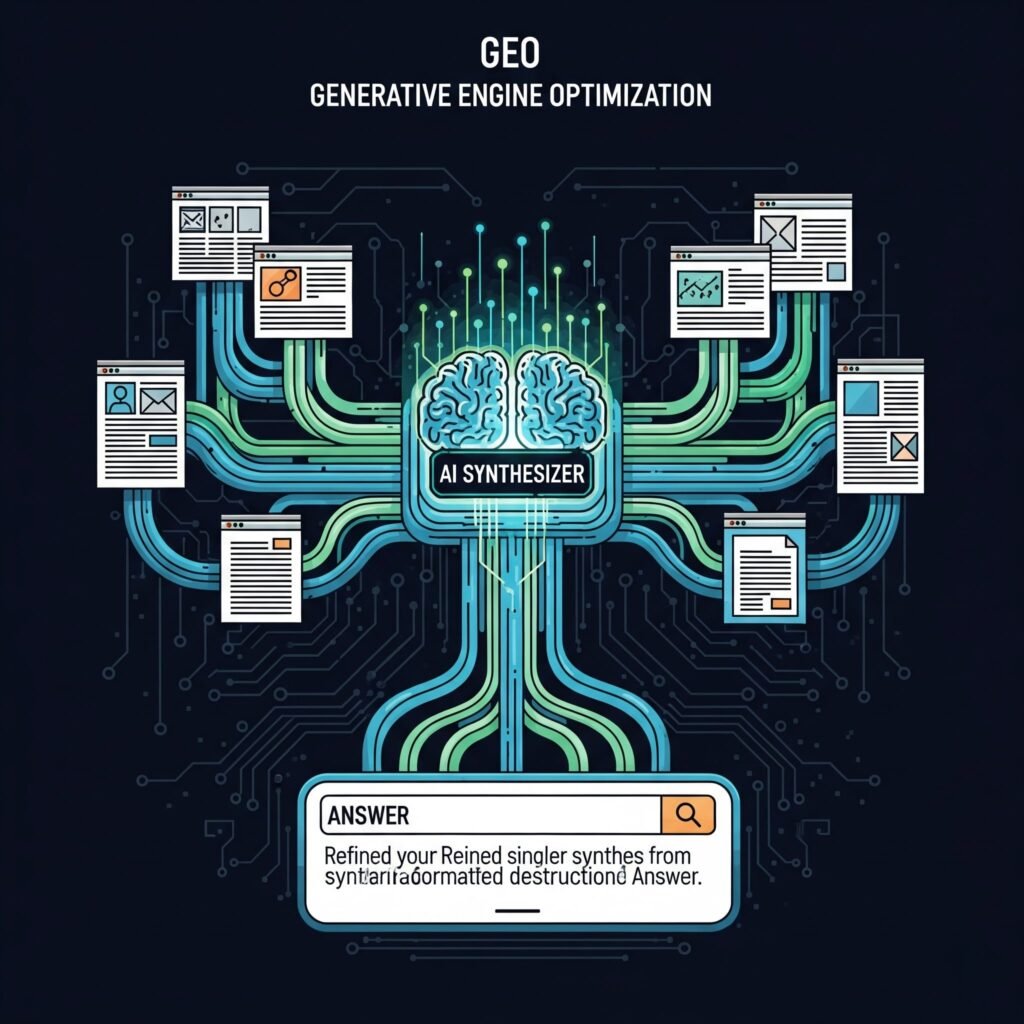What is Generative Engine Optimization (GEO)?

Generative Engine Optimization (GEO) is the next evolution of digital marketing that focuses on optimizing content for AI-powered search engines like ChatGPT, Google’s Gemini, Perplexity, Claude, and other generative AI assistants.
Generative Engine Optimization
Unlike traditional SEO, which relies heavily on keywords, backlinks, and ranking algorithms, GEO ensures that your brand, website, and content remain discoverable when AI tools generate responses for user queries.
In other words, instead of only asking, “How do I rank on Google’s first page?”, businesses now need to ask, “How do I appear in AI-generated answers?”.
GEO is not a replacement for SEO—it’s a complementary strategy that aligns with the way search and information discovery are evolving in 2025.
Why GEO Matters More Than Traditional SEO
AI-driven platforms are reshaping how people search for and consume information:
- AI assistants replace browsing: Instead of visiting multiple websites, users increasingly rely on one AI-generated answer.
- Decline in organic clicks: Traditional “10 blue links” search results are becoming less important as AI summarizes answers.
- Trust shifts to AI: People trust ChatGPT, Gemini, or Perplexity to deliver reliable responses. If your brand isn’t optimized for GEO, you risk being invisible in this new ecosystem.
A recent survey showed that 58% of Gen Z and Millennials prefer using AI assistants over Google for quick answers. That means GEO is not optional—it’s mandatory for future-proofing digital visibility.
Generative Engine Optimization
Key Strategies for GEO Success in 2025
Here are practical ways businesses can adapt their marketing strategies to succeed with Generative Engine Optimization:
1. Create Authoritative & Trustworthy Content
Generative AI systems prioritize credible and trustworthy sources when pulling data. That means:
- Build E-E-A-T (Experience, Expertise, Authoritativeness, Trustworthiness).
- Use original research, case studies, and data-driven insights.
- Highlight real-world experience (quotes, expert authors, certifications).
2. Optimize for Conversational Queries
Generative AI thrives on natural language processing. Businesses should:
- Use long-tail conversational keywords like “What are the best marketing automation tools for small businesses in 2025?”.
- Include FAQs in content to answer likely AI-generated questions.
- Write in a clear, direct, and helpful tone, since AI prefers structured responses.
3. Structured Data & AI Metadata
Just as SEO uses schema markup, GEO requires structured data for AI:
- Implement schema for products, reviews, authors, and events.
- Use new protocols like llms.txt (a file that tells AI crawlers how to use your content).
- Provide machine-readable metadata to help AI classify your site correctly.
4. Build Digital Authority Beyond Websites
AI models don’t just scan websites—they look at multi-platform signals:
- Be active on LinkedIn, Medium, YouTube, and podcasts.
- Secure mentions in credible publications (PR, guest posts).
- Ensure consistent branding across platforms to strengthen your digital footprint.
5. Content Designed for AI Summaries
Generative AI favors clear, structured, digestible content:
- Break articles into short paragraphs, lists, and bullets.
- Provide direct answers upfront (AI loves summaries).
- Add statistics, tables, and data points for AI models to extract.
Generative Engine Optimization
Structured Data, llms.txt, and AI Metadata
One of the most exciting shifts in GEO is the rise of llms.txt, similar to robots.txt.
- llms.txt allows publishers to control how their data is used by AI models.
- Businesses can decide whether AI crawlers (like OpenAI or Google Gemini) can index, summarize, or cite their content.
- This file is expected to become an essential GEO tool by late 2025, allowing publishers to balance visibility with content rights.
Structured data also plays a vital role. By using schema markup, businesses help AI understand the context of content, improving the chance of being cited as a trusted source in AI answers.
Challenges in Implementing GEO

Generative Engine Optimization
While GEO is exciting, it also brings challenges:
- Lack of Standards: Unlike SEO, GEO doesn’t yet have universally accepted rules.
- Over-Reliance on AI: Businesses risk losing direct website traffic if AI answers everything.
- Brand Misrepresentation: AI may summarize content inaccurately, affecting trust.
- Content Ownership Issues: Who gets credit when AI uses your content in its answers?
Despite these hurdles, companies that adapt early will secure a competitive edge in visibility.
Generative Engine Optimization
Case Examples of Early Adopters
Some industries are already experimenting with GEO:
- Healthcare: Medical blogs are structuring FAQs and citing sources so AI tools pull accurate health information.
- E-commerce: Online retailers optimize product descriptions with structured data, so AI assistants recommend their products.
- Education: EdTech companies are building GEO strategies to ensure AI tutors recommend their platforms.
These examples show that GEO is not a future idea—it’s already happening.
Future Outlook: Preparing for AI-First Search
By 2026, experts predict that over 70% of online searches will start with AI assistants instead of search engines.
That means GEO will evolve into:
- AI-first marketing strategies, where GEO sits alongside SEO and paid ads.
- New analytics tools, showing how often your brand appears in AI-generated answers.
- Content partnerships with AI platforms, where businesses ensure citations and visibility.
The future belongs to businesses that can adapt quickly and embrace GEO as part of their MarTech strategy.
Generative Engine Optimization
Final Thoughts
Generative Engine Optimization (GEO) is more than just a buzzword—it’s a paradigm shift in how brands remain discoverable in an AI-powered digital world.
Businesses that embrace GEO will:
- Stay visible in AI-generated search results.
- Build credibility and brand trust.
- Future-proof their digital marketing strategy for the next decade.
As 2025 unfolds, GEO will be the ultimate competitive advantage in MarTech. The earlier you adapt, the stronger your positioning will be when AI-first search becomes the global standard.
AI Chatbots in Marketing: Boosting Customer Engagement in 2025
Introduction to AI Chatbots in Marketing AI chatbots in marketing Marketing in 2025 looks very…
Generative Engine Optimization (GEO): The Future of SEO in 2025
Introduction Generative Engine Optimization (GEO): The Future of SEO in 2025 Generative Engine Optimization The…
AI-Powered CRM Software for Modern Businesses: The Future of Customer Relationship Management
AI-Powered CRM Software for Modern Businesses: The Future of Customer Relationship Management Introduction In today’s…
Maximizing ROI with AI Powered Marketing Automation: Real-World Insights & Future Outlook
Introduction AI Powered Marketing Automation AI Powered Marketing Automation In 2025, marketing automation isn’t just…
How Marketing Automation Streamlines Customer Onboarding in 2025
Introduction Marketing Automation Streamlines Customer Onboarding First impressions matter in business. When a customer signs…
The Future of AI Powered Email Marketing: Strategies for 2025
Introduction AI powered email marketing Email marketing remains one of the most powerful channels for…


Pingback: The Future of CRM in 2025: Key Innovations Shaping Customer Relationships